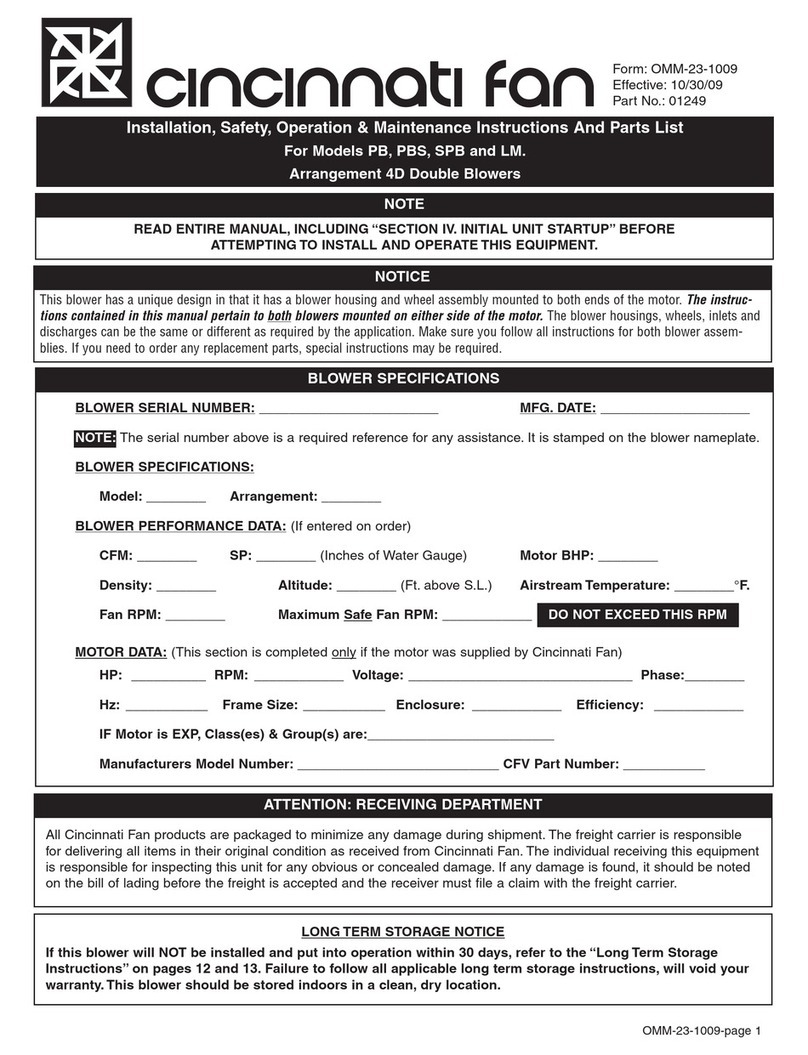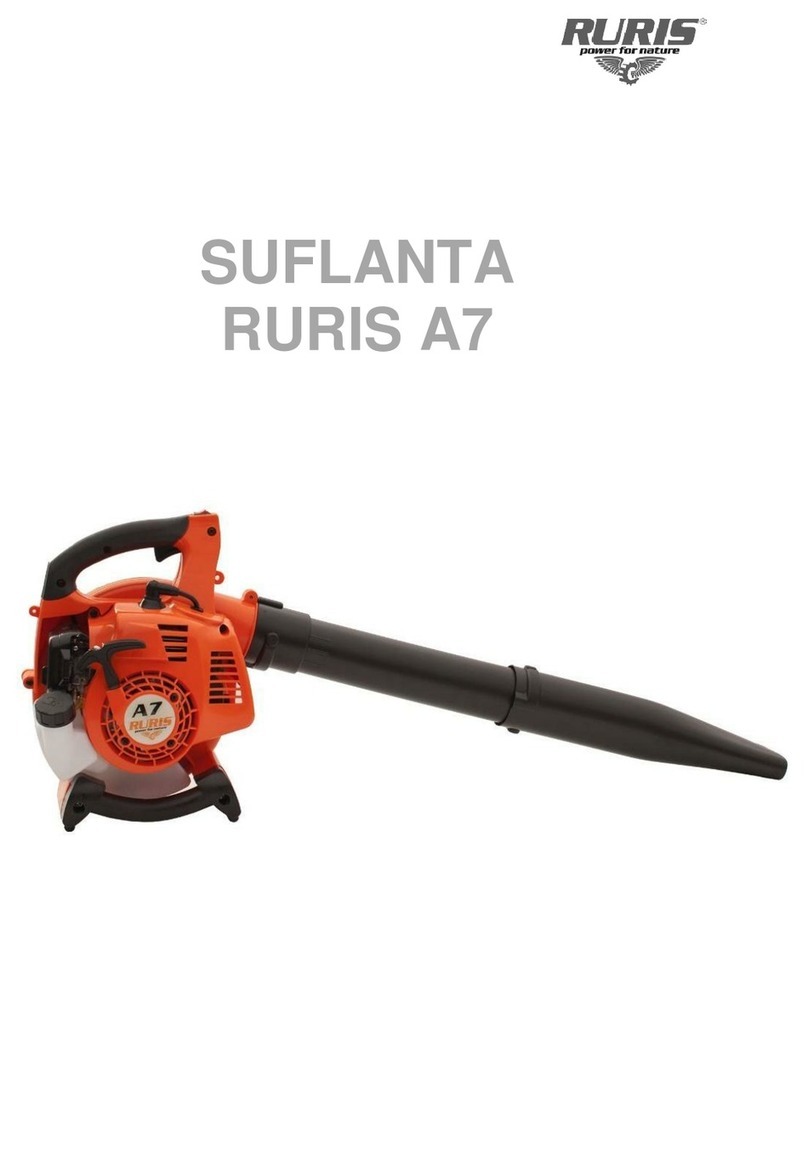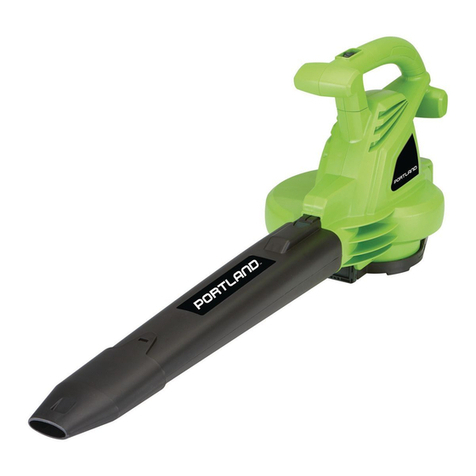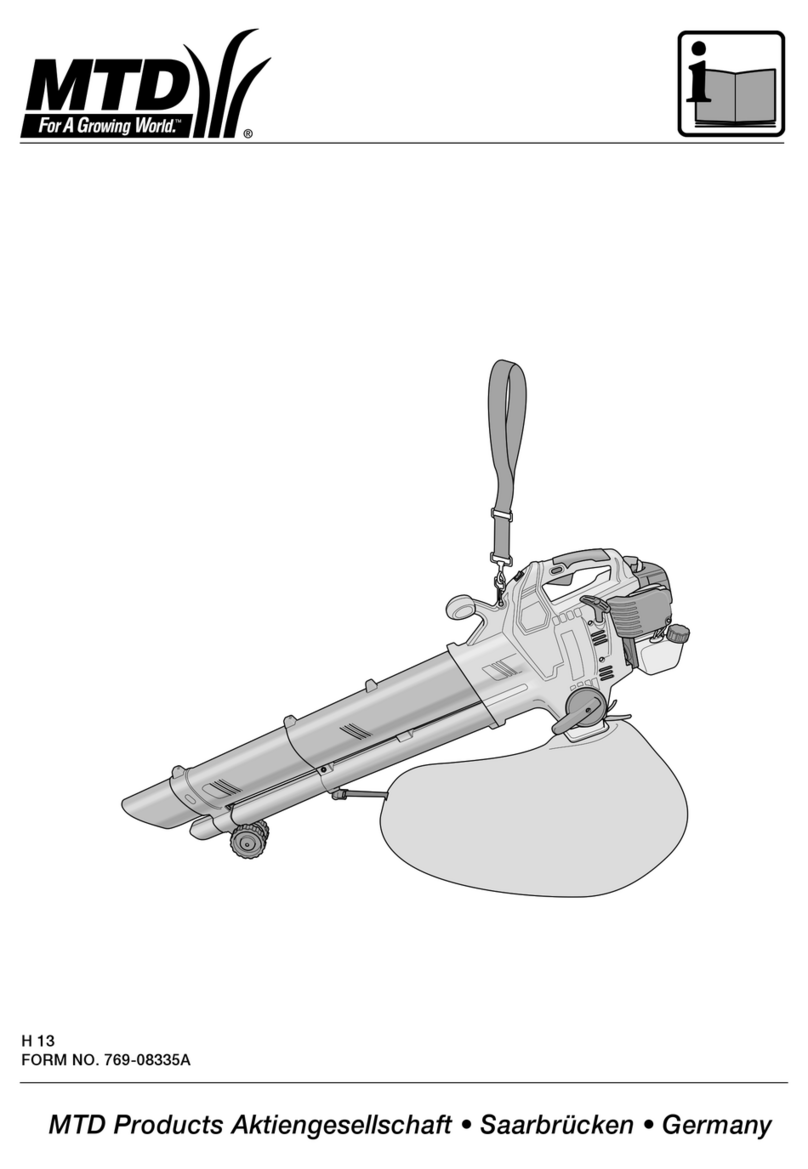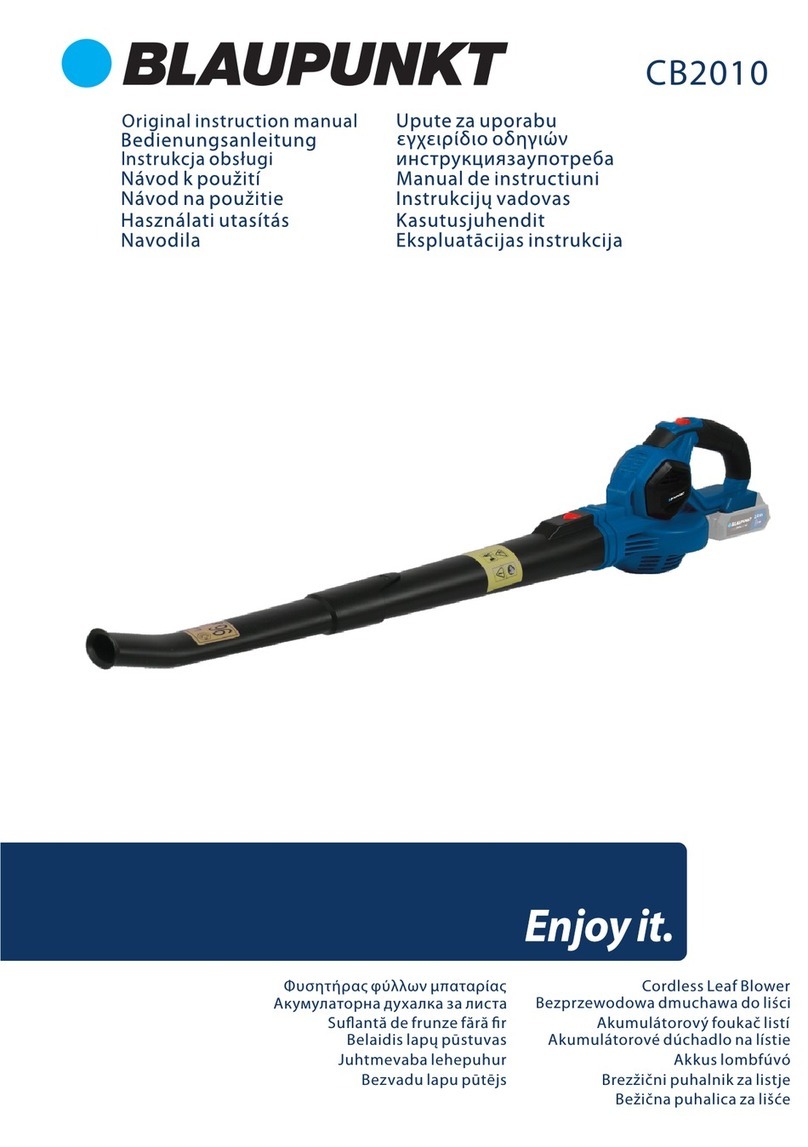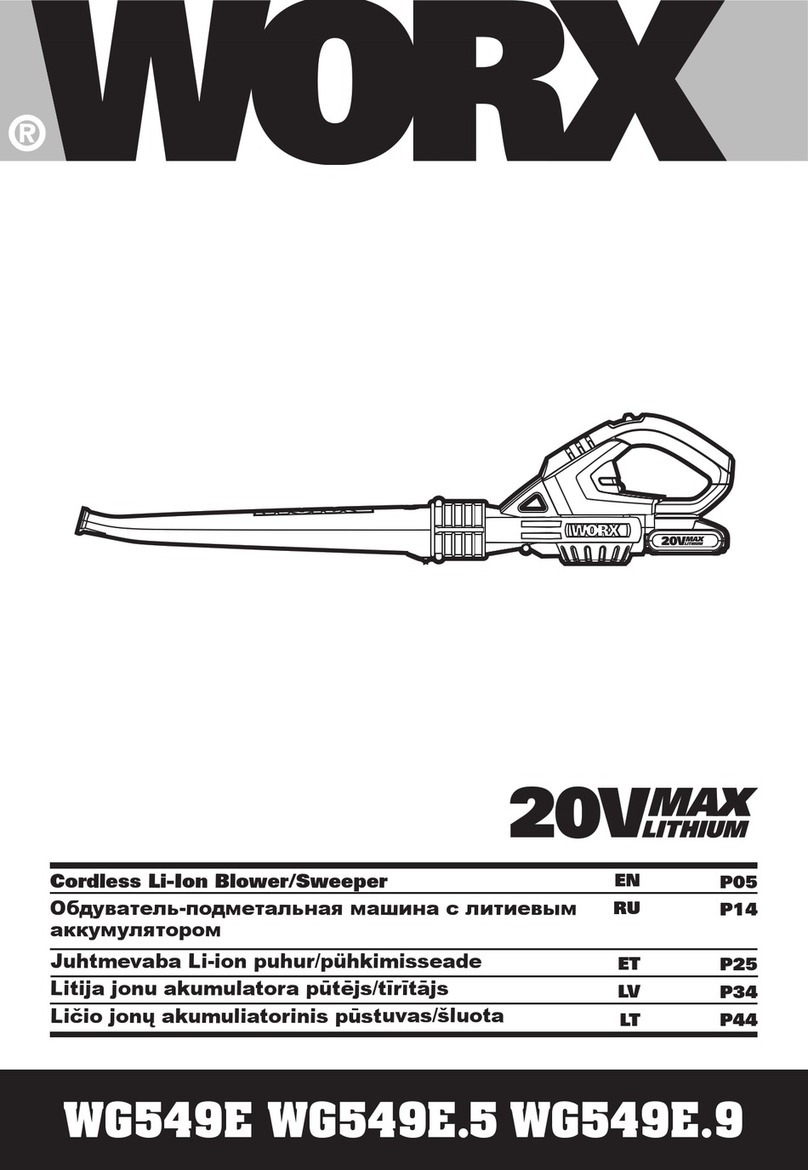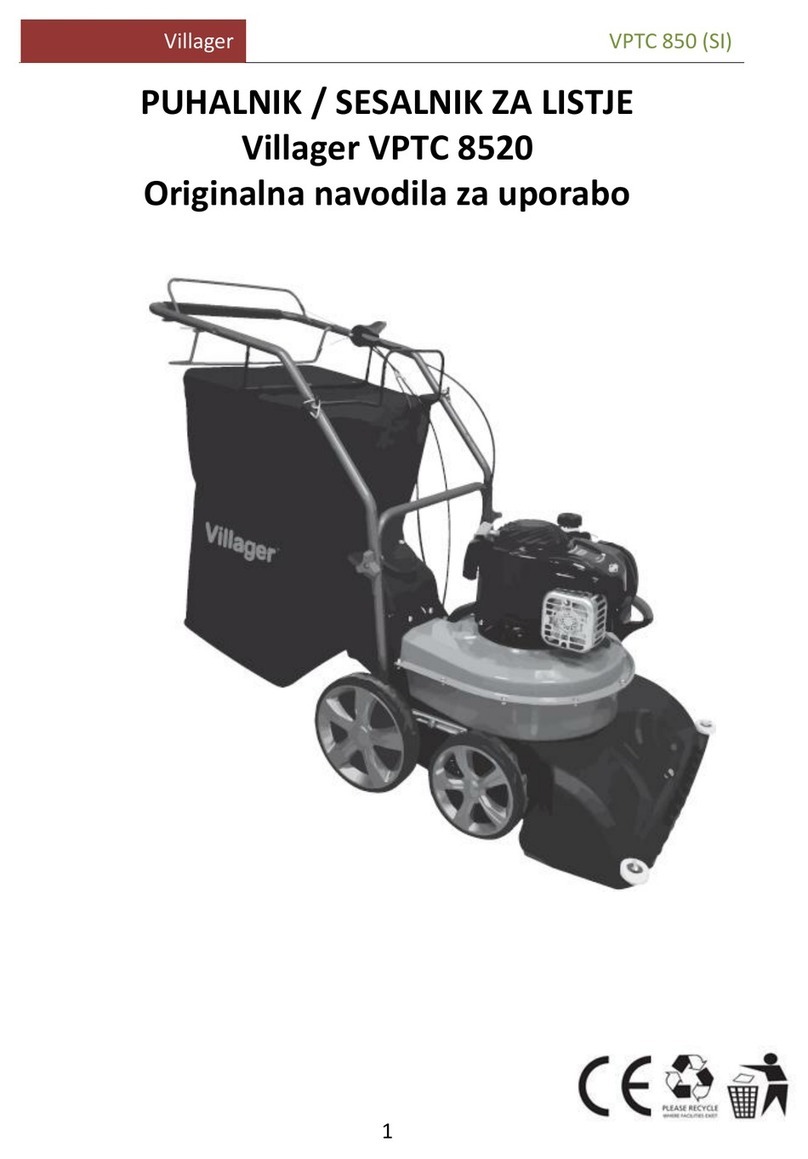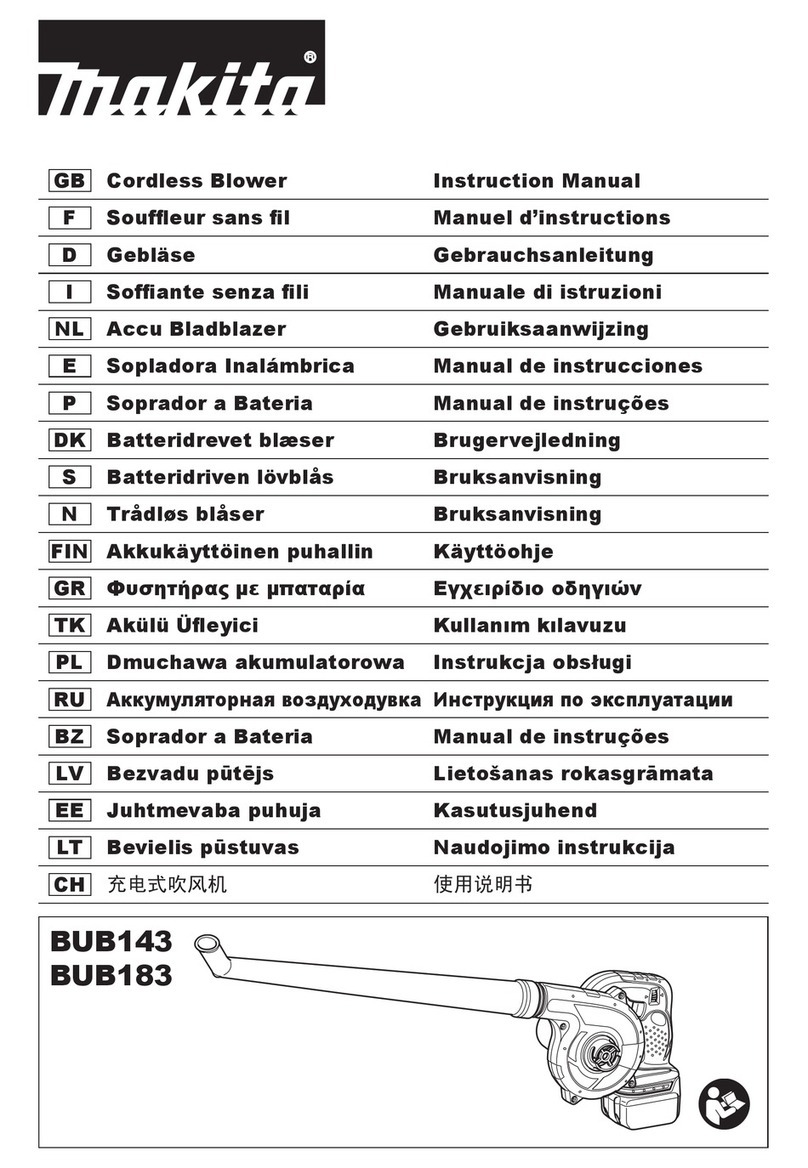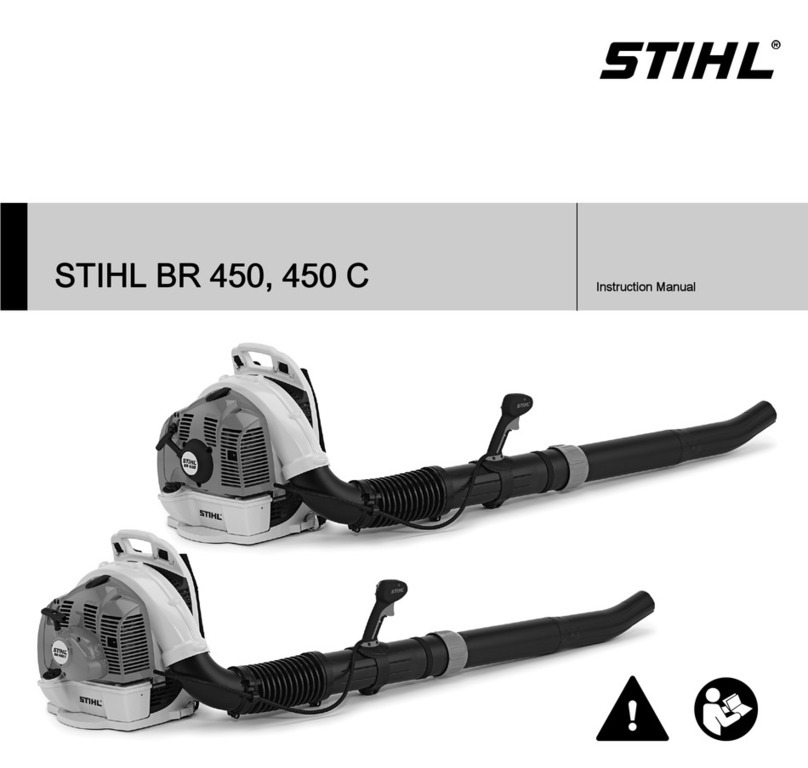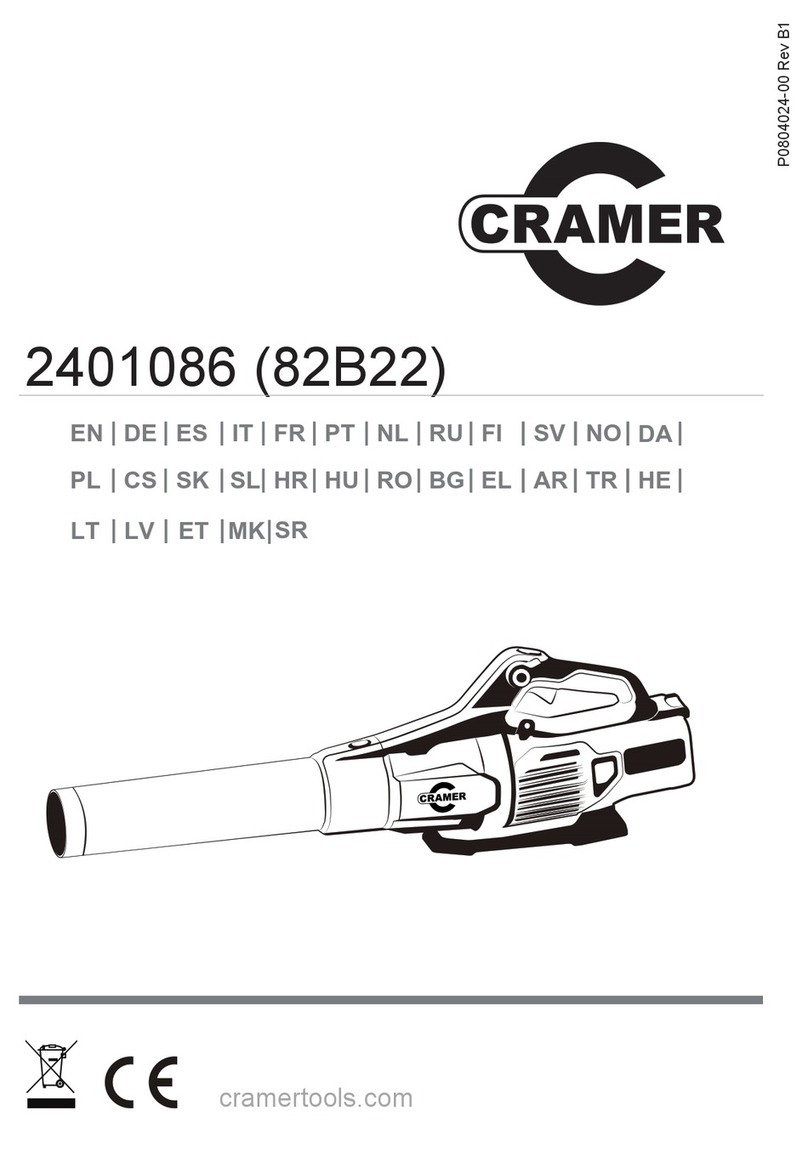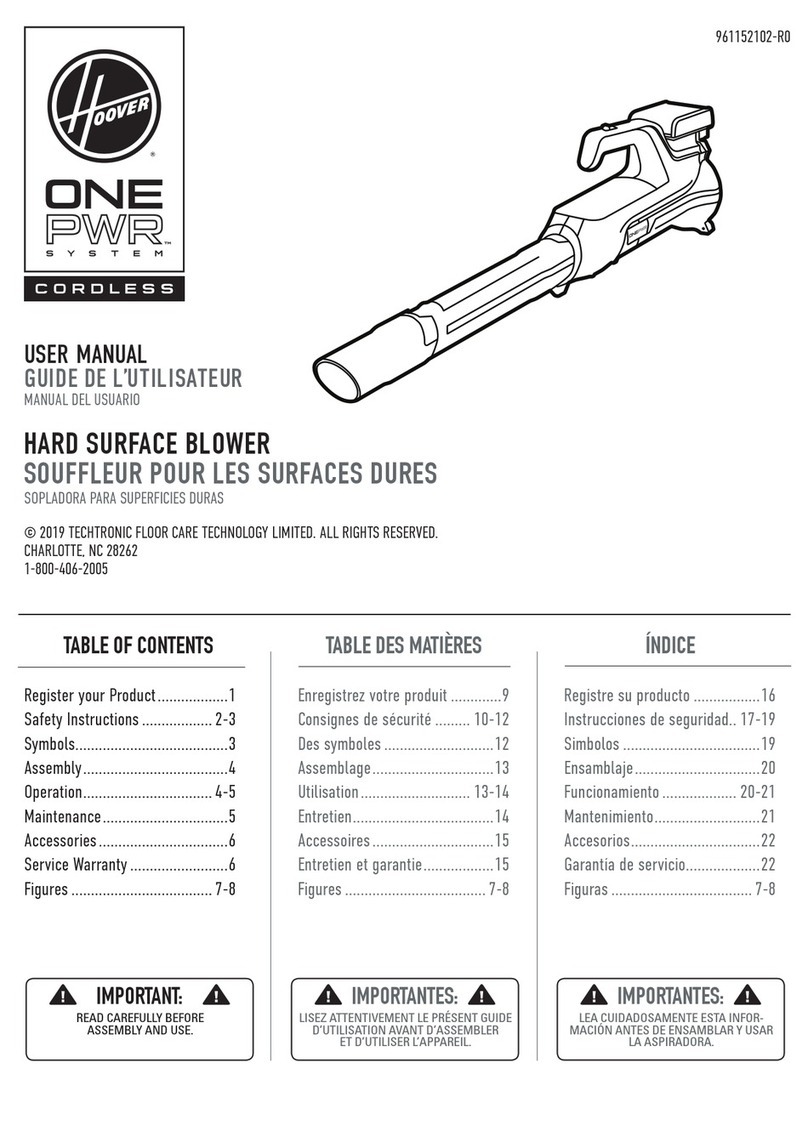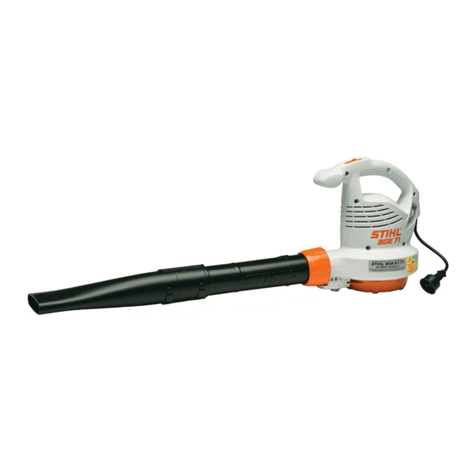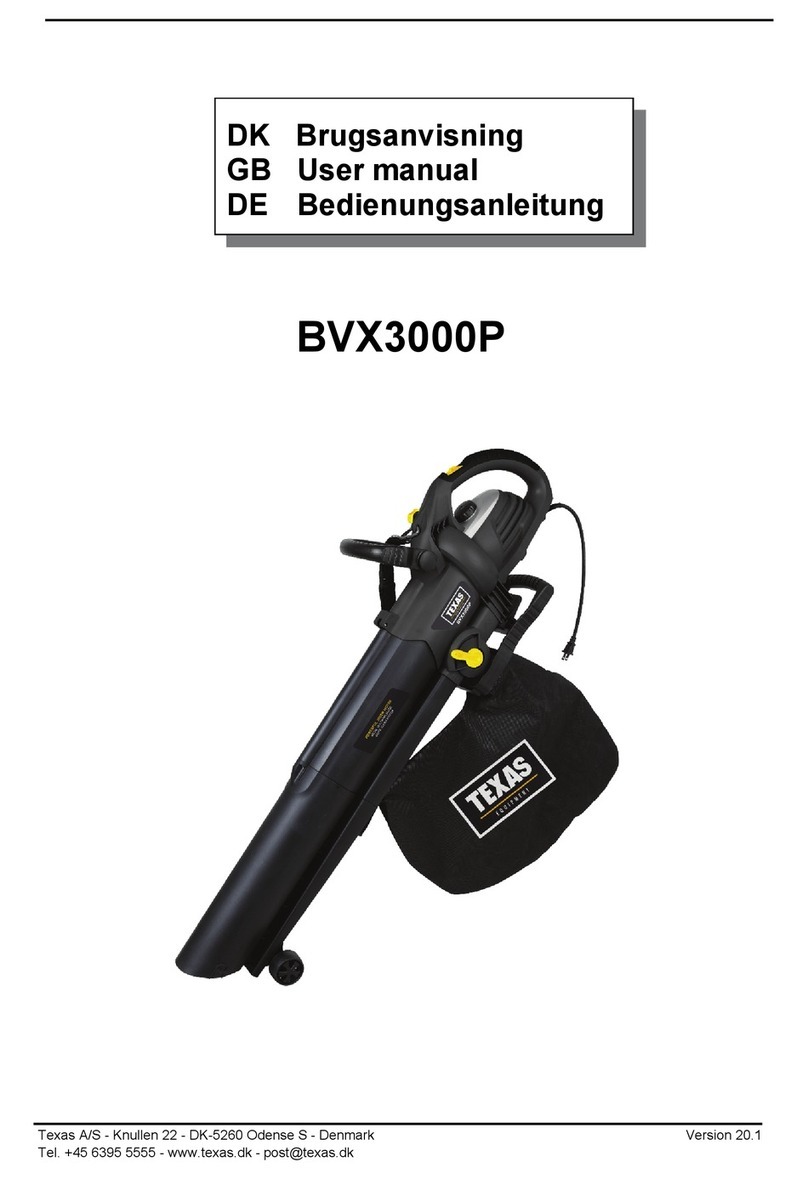Cincinnati Fan PB Installation and operation manual

ALL FANS AND BLOWERS SHOWN HAVE ROTATING PARTS AND PINCH POINTS. SEVERE
PERSONAL INJURY CAN RESULT IF OPERATED WITHOUT GUARDS. STAY AWAY FROM ROTATING
EQUIPMENT UNLESS IT IS DISCONNECTED FROM ITS POWER SOURCE AND ALL ROTATING
PARTS HAVE STOPPED MOVING.
READ ALL OPERATING INSTRUCTIONS CONTAINED HEREIN
BEFORE INSTALLING EQUIPMENT.
NO GUARANTEE OF ANY LEVEL OF SPARK RESISTANCE IS IMPLIED BY SPARK RESISTANT
CONSTRUCTION. IT HAS BEEN DEMONSTRATED THAT ALUMINUM IMPELLERS RUBBING ON
RUSTY STEEL MAY CAUSE HIGH INTENSITY SPARKS. AIR STREAM MATERIAL AND DEBRIS OR
OTHER SYSTEM FACTORS MAY ALSO CAUSE SPARKS.
for
PB - Cast Aluminum Pressure Blowers
SPB - Stamped Steel Pressure Blowers
PBS - Fabricated Steel Pressure Blowers
LM - Volume Blowers
CONTENTS
I. General Safety Notes ...........................Page 2
Il. Receiving..............................................Page 2
lll. Handling................................................Page 2
IV. General Installation Instructions............Page 2
V. Operation...............................................Page 3
Vl. General Maintenance ...........................Page 3
VII.V-belt Drives..........................................Pages 4 & 5
VllI. Bearing Maintenance............................Pages 4 & 5
IX.Warranty................................................Page 5
X. Ordering Replacement Parts................Page 6
XI.Trouble Shooting...................................Page 6
XlI. Assembly Drawings..............................Pages 7 & 8
OPERATING & MAINTENANCE INSTRUCTIONS
AND PARTS LIST
PART # 01111
CATALOG #PMA-302
SUPERSEDES: PMA-793
7697 Snider Road, Mason, Ohio 45040-9135 (513) 573-0600
NOTICE
If fan will not be put into operation within 30 days, obtain long-term storage instructions from our website
(www.cincinnatifan.com) or your local Cincinnati Fan Sales Office.

1. Rotating parts including shaft and V-belt drives must
be properly guarded to prevent personal injury.
2. Electrical wiring must be accomplished by a qualified
electrician in accordance with all applicable codes.
3. Care should be taken:
• Not to run fan above its safe speed
(See Performance Tables in Sales Catalog or
call CF sales office).
• Not to operate in excessive temperatures
(See limitations in Sales Catalog or call CF
sales office).
• Not to operate in dangerous environments.
• Read all instructions carefully.
Receiving Inspection
When unit is received, inspect immediately for damaged
or missing parts. Even though all units are carefully
inspected and prepared for shipment at the factory,
rough handling en route may cause concealed damage
or cause nuts, set screws, bolts or locking collars to
work loose. Be certain all fasteners are tightened
securely. Rotate wheel by hand to verify that it rotates
freely and that there are no obstructions.
Inspect all shipments carefully for damage. The
receiver must note any damage on the carrier’s bill
of lading and file a claim immediately with the
freight company in case of damage. Keep a record of
all equipment received, including inspection details and
date of receipt because of the possibility of partial
shipments.
Handle your equipment with care. Some fans are
provided with lifting lugs or holes for easy handling.
Others must be handled using nylon straps or well-
padded chains and cables which protect the fan’s
coating and housing. Spreader bars should be used
when lifting large parts.
Centrifugal fans are best lifted using one strap under the
fan’s scroll and another strap around the bearing base.
DO NOT LIFT CENTRIFUGAL FANS BY THE FAN
SHAFT, WHEEL, FLANGES, INLET SUPPORT OR
MOTOR EYE BOLT.
Foundations
Fan foundation must be flat, level and rigid.Where
foundation is not completely flat, shims must be placed
under fan support at each anchor bolt as required.
Bolting fan to an uneven foundation distorts alignment
and causes vibration.
Structural steel foundations should be heavily cross-
braced for load support.
2
I. GENERAL SAFETY NOTES
II. RECEIVING
III. HANDLING
IV. GENERAL INSTALLATION INSTRUCTIONS
NOTE: If wheel set screws are loosened and/or wheel is removed from shaft, set screws must be replaced.
Set screws cannot be used more than once. Use knurled, cup point set screws with a locking patch.
TORQUE VALUES FOR SPLIT TAPER BUSHINGS
SET SCREWTORQUE VALUES
MINIMUM RECOMMENDED
TORQUE (INCH-LBS)
Bushing Size
H
B & P
Q & R
195
192
350
SET SCREW SIZE MINIMUM
REQUIREDTORQUE
(INCH-LBS)
Diameter & No.
ofThreads/Inch
1/4-20
5/16-18
3/8-16
7/16-14
1/2-13
5/8-11
65
165
228
348
504
1104
1/8"
5/32"
3/16"
7/32"
1/4"
5/16"
Hex Size Across
Flats (AllenWrench)
Table #2
Table #1
NOTICE
If fan will not be put into operation within 30
days, obtain long-term storage instructions from
our website (www.cincinnatifan.com) or your local
Cincinnati Fan Sales Office.

Before Connecting Power
1. Inspect all fasteners and retighten if necessary:
a. Foundation bolts.
b. Set screws in fan and wheel and V-belt drive
(See Tables #1 & #2 on preceding page).
c. Housing, bearing and motor mounting.
2. Any inspection doors should be tight and sealed.
3. Bearings should be checked for alignment and
lubrication (See Bearing Maintenance, pages 4 & 5).
4.Turn rotating assembly by hand to insure that it does
not strike housing. If the wheel strikes the housing,
the wheel may have moved on the shaft or the
bearings may have shifted in transit. Correction must
be made prior to start up.
5. Check motor to insure proper speed and electrical
characteristics.
6. Check V-belt drive for alignment and correct belt
tension.
7. After wiring, energize motor for one second to check
for proper rotation.
The key to good fan maintenance is a regular and
systematic inspection of all fan parts. Severity of the
application should determine frequency of inspection.
The components requiring service are generally the
moving parts which include bearings, fan wheel, belts,
sheaves and motor.
Cast Aluminum & Metal Parts
Cast aluminum and steel parts usually do not require
maintenance during the life of the unit except painted
metal surfaces that may require periodic repainting. In a
severe, dirty operation, the wheel should be cleaned
with a wire brush to prevent an accumulation of foreign
matter that could result in fan unbalance. After cleaning
wheel, inspect for possible cracks or excessive wear,
which can cause unbalance. DO NOT operate a wheel
that is cracked, chipped, has broken blades or excessive
wear. NOTE: If wheel set screws are loosened and/or
wheel is removed from shaft, set screws must be
replaced. Set screws cannot be used more than once.
Belts on V-belt drive units require periodic inspection
and replacement when worn. For multiple belt drives,
belts should be replaced with matched sets.
Motor Maintenance
1. Disconnect or lock out power to motor.
2. Removing dust and dirt: Blow out open type motor
windings with low pressure air to remove dust or dirt.
Air pressure above 50 P.S.I. should not be used as
high pressure may damage insulation and blow dirt
under loosened tape. Dust accumulation can cause
excessive insulation temperatures.
3. Lubrication: The motor bearings and the fan bearings
on the belt drive fans should be greased at regular
intervals. Motor manufacturers’greasing instructions
and recommendations should be followed closely.
Avoid the use of a pressure greasing system which
tends to fill the bearing chamber completely. Do not
overgrease. Use only 1 or 2 shots with a hand gun in
most cases. Maximum hand gun rating 40 P.S.I.
Rotate bearings during lubrication where good safety
practice permits.
NOTE: On motors with non-regreasable, sealed
bearings, no lubrication is required for the life of the
bearings.
To prevent rusting of bearing parts, the motor shaft must
be rotated at regular intervals (30 days) to assure these
parts are well covered with oil or grease.
3
VI. GENERAL MAINTENANCE
Before any maintenance or service is performed,
assure that unit is disconnected or locked out from
power source to prevent accidental starting.
CAUTION
A WORD OF CAUTION
ABOUT MOTORS
Using your hand to test the running temperature of
a motor can be a very painful experience:
Normal body temperature ..........................98.6°F
Threshold of pain caused by heat............120.0°F
Average temperature of hot tap water......140.0°F
Average temperature of hot coffee...........180.0°F
Normal operating temperature of a
fully loaded electric motor open type,
70°F ambient temperature .....................174.0°F
V. OPERATION

Care should be taken not to overtighten V-belt
drive. Excessive belt tension overloads fan and
motor bearings. It is much less expensive to
replace belts worn from slippage than to
replace bearings damaged from excessive
loading.
Fans shipped completely assembled have had V-belt
drive aligned at the factory. Alignment should be
rechecked before operation as a precaution due to
handling during shipment.
1. Be sure sheaves are locked in position.
2. Key should be seated firmly in keyway.
3. Place straight edge or taut cord across faces of
driving and driven sheaves to check alignment.The
motor and fan shafts must be parallel and V-belts
must be at right angles to the shafts.
4. Start the fan. Check for proper rotation. Run fan at full
speed. A slight bow should appear on slack side of
belt. Disconnect power and adjust belt tension by
adjusting motor on its sliding base. All belts must have
some slack on one side.
5. If belts squeal at start up, they may be too loose.
6. When belts have had time to seat in the sheave
grooves, then readjust belt tension (2-3 days).
4
Conditions Around Bearing Operating Temperature of Fan **Greasing Intervals
Fairly Clean up to 120 °F 6-12 months
120°-160°F 2-3 months
160°-200°F plus* 1-2 months
Moderate to up to 160°F 1-2 months
Extremely Dirty 160°-200°F plus* 2-4 weeks
Cold Storage Room every defrosting period or
no more than 4 months
*For fan applications over 200°F: greasing intervals should be from several days to 2 weeks, depending
on the temperature.
**For vertical installations, greasing intervals should be twice as frequent as table values.
The following greases, or one that is equivalent to the general description, are recommended for the following
temperatures or excessive moisture applications.
Operating Conditions Use Grease Equivalent to these Grades
Esso-Beacon #325 (-65°F)
Temperatures -65°F to 0°F Mobil Grease #28 (-65°F)
Shell Oil Aeroshell No. 7 (-100°F)
General Description: Versatile multipurpose microgel thickened synthetic hydrocarbon grease with corrosion
inhibitors, anti-oxidant additives, water resistance tendencies and EP characteristics.
Temperature 0°F to 200°F inclusive Mobil Oil - Mobilux EP #2
(Also use for heavy condensation Shell Oil - Shell Alvania EP #2
or direct splash of water) Chevron - Chevron SRI #2
General Description: Multipurpose NLGI#2 grease from lithium soap with EP characteristics, rust inhibitors,
anti-oxidant additives and good water resistance tendencies.
Temperatures over 200°F Dow Corning-DC44 (400°F)
(Not compatible with non-silicon based greases)
General Description: Versatile multipurpose microgel thickened synthetic hydrocarbon grease with corrosion
inhibitors, anti-oxidant additives, water resistance tendencies and EP characteristics.
Table #3 (See Bearing Maintenance, page 5.)
VII.V-BELT DRIVES

V-belt drive assembly can be mounted as follows:
1. Clean motor and fan shafts. Be sure they are free
from corrosive material. Clean bore of sheaves and
coat with heavy oil for ease of shaft entry. Remove oil,
grease, rust or burrs from sheave grooves.
2. Place fan sheave on fan shaft and motor sheave on
its shaft. Do not pound sheaves on as this may
damage bearings.Tighten sheaves per Table #1 or #2
on page 2.
3. Move motor on slide base so belts can be placed in
grooves of both sheaves without forcing. Do not roll
belts or use a tool to force belts over the grooves.
4. Align fan and motor shafts so they are parallel.The
belts should be at right angles to the shafts. A straight
edge or taut cord placed across the face of the
sheaves will aid in alignment.
5. Tighten belts by adjusting motor base. Correct tension
gives the best drive efficiency. Excessive tension
causes undue bearing pressure.
6. Start the fan and run it at full speed. Adjust belt
tension until only a slight bow appears on the slack
side of the belts. If slippage occurs, a squeal will be
heard at start-up. Eliminate this squeal by
disconnecting or locking out motor from power
source and then tightening up the belts.
7. Give belts a few days running time to become seated
in sheave grooves, then readjust belt tension.
If the shafts become scratched or marked, carefully
remove sharp edges and high spots such as burrs with
fine emery cloth or honing stone. Avoid getting emery
dust in the bearings.
Do not apply any belt dressing unless it is recommend-
ed by the drive manufacturer.V-belts are designed for
frictional contact between the grooves and sides of the
belts. Dressing will reduce this friction.
Belt tension on an adjustable pitch drive is obtained by
moving the motor, not by changing the pitch diameter of
the adjustable sheave.
Sealed Bearings
Sealed for life bearings are pre-lubricated with the
correct amount of manufacturer approved ball bearing
grease, and are designed for application where
relubrication is not required.
Relubricatable Bearings
The motor bearings and fan bearings on belt drive fans
should be greased at regular intervals. Motor manufac-
turers greasing instructions and recommendations
should be followed closely. Avoid the use of a pressure
greasing system which tends to fill the bearing chamber
completely. Do not over grease.
NOTE: On motors with non-regreasable, sealed
bearings, no lubrication is required for the life of the
bearing.
Table #3 (page 4) lists the time intervals between fan
greasing to insure proper lubrication in adverse
conditions of heat and dust. Use only 1 or 2 shots with a
hand gun in most cases. Maximum handgun rating 40
P.S.I.
Cincinnati Fan & Ventilator Company warrants products
of its own manufacture against defects of material and
workmanship under normal use and service for a period
of eighteen (18) months from date of shipment or twelve
(12) months from date of installation, whichever occurs
first.
This warranty does not cover ordinary wear and tear,
abuse, misuse, overloading, negligence, alteration or
systems and/or materials not of Seller’s manufacture.
Expenses incurred by Buyer(s) in repairing or replacing
any defective product will not be allowed except where
authorized in writing and signed by an officer of the
Seller.
The obligation of Seller under this warranty shall be
limited to repairing or replacing F.O.B. Seller’s plant, or
allowing credit at Seller’s option. This warranty is
expressly in lieu of all other warranties expressed or
implied including the warranties of merchantability and
fitness for use and of all other obligations and liabilities
of the Seller.The Buyer acknowledges that no other
representations were made to him or relied upon him
with respect to the quality or function of the products
herein sold.
On equipment furnished by the Seller, but manufactured
by others, such as motors, Seller extends the same
warranty as Seller receives from the manufacturer
thereof. Repairs for motors should be obtained from
nearest authorized motor service station for the make of
motor furnished. All motors used are products of well-
known manufacturers with nationwide service facilities.
Check the yellow pages of your telephone directory for
the location of the nearest service shop.
Cincinnati Fan & Ventilator Company assumes no
responsibility for material returned to our plant without
our prior written permission.
5
VIII. BEARING MAINTENANCE
IX.WARRANTY

Replacement or spare parts may be ordered through
your local Cincinnati Fan representative. (Refer to
drawings that begin on page 7.) The following
information should accompany parts orders:
1. Motor horsepower, frame size, motor speed, voltage,
phase, cycle and enclosure. Motor manufacturer’s
model number from motor nameplate.
2. Fan Speed (if V-belt driven).
3. Fan serial and model numbers from the fan
nameplate and a complete description of the part.
An adequate stock of repair parts is maintained where
possible. If your fan is vital to production or to plant
operation, it is advisable to have all spare parts on
hand to minimize downtime.
In the event that trouble is experienced in the field, the
following are the most common fan difficulties.These
points should be checked in order to prevent needless
delay and expense.
1. CAPACITY OR PRESSURE BELOW RATING
a.Incorrect direction of wheel rotation.
b. Speed too slow.
c.Dampers not properly adjusted.
d.Poor fan inlet or outlet conditions (elbows,
restrictions).
e.Air leaks in system.
f. Damaged wheel.
g.Total resistance of system higher than
anticipated.
h.Wheel mounted backwards on shaft.
i.Fan not properly selected for a high temperature
and/or high altitude application.
2. VIBRATION AND NOISE
a. Misalignment of bearings, coupling, wheel
or V-belt drive.
b. Unstable foundation or supports.
c. Foreign material in fan causing unbalance.
d. Worn bearings.
e. Damaged wheel or motor.
f. Broken or loose bolts and set screws.
g. Bent shaft.
h. Worn coupling.
i. Fan wheel or drive unbalanced.
j. 120 cycle magnetic hum due to electrical
input. Check for high or unbalanced voltage.
k. Fan delivering more than rated capacity.
I. Loose dampers.
m. Speed too high or fan rotating in wrong
direction.
n. Vibration transmitted to fan from some
other source.
3. OVERHEATED BEARINGS
a. Check bearing lubrication.
b. Poor alignment.
c. Damaged wheel or drive.
d. Bent shaft.
e. Abnormal end thrust.
f. Dirt in bearings.
g. Excessive belt tension.
4. OVERLOAD ON MOTOR
a. Speed too high.
b. Fan over capacity due to existing system
resistance being lower than original rating.
c. Specific gravity or density of gas above
design value.
d. Wrong direction of wheel rotation.
e. Shaft bent.
f. Poor belt alignment.
g. Wheel wedging or binding on fan housing.
h. Bearings improperly lubricated.
i. Motor improperly wired.
j. Defective motor. Motor must be tested by
motor manufacturer’s authorized repair shop.
6
XI.TROUBLE SHOOTING
X. ORDERING REPLACEMENT PARTS

7
MODELS PB, SPB & LM
HOUSING/WHEEL COMPONENTS
All Arrangements
*1. Inlet side plate (if required).
*2. Housing, inlet side.
*3. Wheel (Radial or Forward Curve).
4. Housing, drive side.
5. Drive side plate (if required).
* NOTE: Rotation determined by viewing
blower from drive side, not
looking into inlet.
MODELS PBS
FABRICATED HOUSING/WHEEL
COMPONENTS
All Arrangements
*1. Inlet side plate.
*2. Wheel (Radial or Forward Curve).
3. Housing, non-reversible (CW or
CCW).
* NOTE: Rotation determined by viewing
blower from drive side, not looking
into inlet.
Arrangement 4 - Type 1
BASE COMPONENTS
1. Motor.
2. Combo base.
3. Riser blocks (if required).
4. Riser base, 1-3/4”(if required).
Arrangement 4 - Type 2
BASE COMPONENTS
1. Motor.
2. Angle bracket (if required).
3. Bottom base.
4. Riser base (if required).

8
Arrangement 2
BASE COMPONENTS
1. Upright base.
2. Shaft/bearing assembly.
Arrangements 1 & 9
BASE COMPONENTS
1. Spacer ring (not required for
PBS blowers).
2. Shaft/bearing assembly.
3. Fan sheave. (Arr. 9 only).
4. Belt(s). (Arr. 9 only).
5. Bearing base.
6. Motor slide base. (Arr. 9 only)
7. Motor. (Arr. 9 only)
8. Motor sheave. (Arr. 9 only).
9. Belt guard. (Arr. 9 only).
Arrangement 8
BASE COMPONENTS
1. Spacer ring (not required
for PBS blowers).
2. Shaft/bearing assembly.
3. Shaft coupling.
4. Motor.
5. Base.
7M - 3/02, ADV
Other manuals for PB
1
This manual suits for next models
3
Table of contents
Other Cincinnati Fan Blower manuals
